Civil War History
During the Civil War the once peaceful countryside of North Mississippi became a hotly contested theater of military operations. From the first weeks of 1862 until the final days of 1864 Federal and Confederate troops campaigned, fought, bled and died in large numbers in North Mississippi. For nearly three years vital railroads and fertile prairie farmland brought massive armies and daring raiders to the backroads and fields of this area.
While some engagements like the battles of Corinth, Brice’s Crossroads and Tupelo (Harrisburg) have remained notable chapters in the larger history of the War, smaller actions such as the battles of Booneville, Coffeeville and Okolona have oftentimes been overlooked. Campaigns, raids, and expeditions in North Mississippi made permanent marks on the land and in the memories of the soldiers who took part in the bloody conflicts. North Mississippi saw Grierson’s Raid come through the heart of the land and witnessed Forrest’s Cavalry achieve some of their greatest battlefield triumphs.
Below are very brief introductions to some of the most notable actions in North Mississippi during the War:
Siege of Corinth
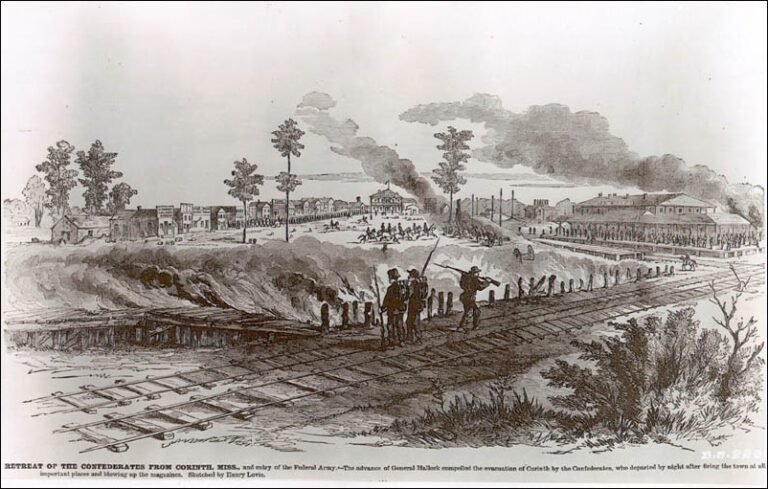
Retreat of the Confederates from Corinth, Miss., and entry of the Federal army–The advance of General Halleck compelled the evacuation from Corinth by the Confederates who departed by night after firing the town at all important places and blowing up the magazines. Sketch by Henry Lovie. (Frank Leslie’s Illustrated Newspaper, June 21, 1862)
The Siege of Corinth was one of the largest operations of the entire American Civil War with
roughly 200,000 troops involved. Prior to the Battle of Shiloh, fought on April 6 and 7, 1862,
most believed the decisive battle in the Western Theater would be fought at Corinth, Mississippi.
However, Shiloh in Tennessee would be the place that Union and Confederate troops would bash
and bloody each other for two devastating days which forever changed the character of the War.
Both armies were hobbled after Shiloh, but neither were destroyed, and the ever-growing Union
Army slowly moved out of their camps around the Shiloh battleground and pushed further south
towards Corinth, a vital railroad junction.
The siege would last from April 29 to May 30, 1862. Union forces under the overall command of
Major General Henry Halleck engaged in a month-long siege of the city, whose Confederate
occupants were commanded by General P.G.T. Beauregard. While there were sizable skirmishes
on the outskirts of Corinth, notably at Farmington, Mississippi, there was not a major decisive
battle, and the Confederates would later pull out of the town leaving the Union forces to take
charge. A month after the siege smaller elements of both forces would clash south of Corinth at
the Battle of Booneville on July 1, 1862. The Union victory helped elevate the reputation of the
Union commander, Phil Sheridan, at the brief and fiery battle.
Battle of Iuka
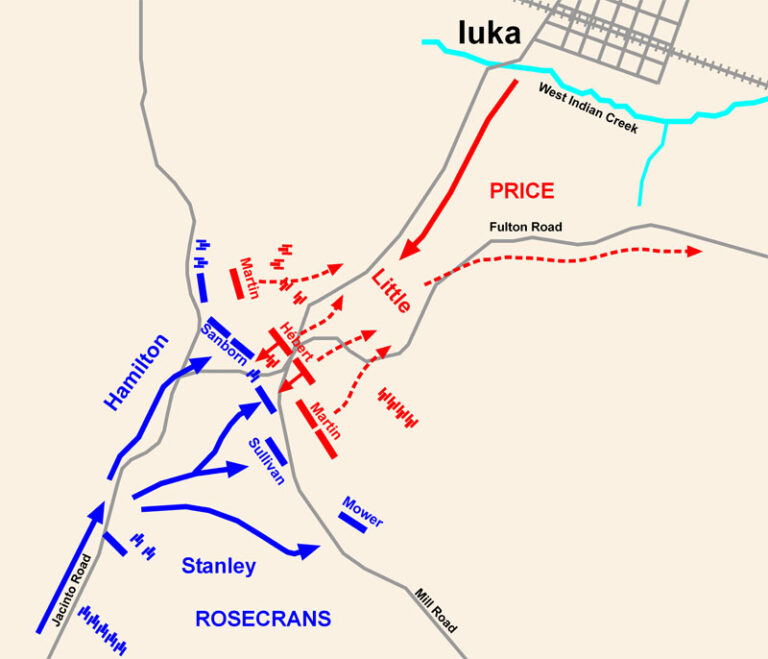
Battle of Iuka of the American Civil War. Drawn by Hal Jespersen in Macromedia Freehand. Graphic source file is available at http://www.posix.com/CWmaps/
The Battle of Iuka was fought on September 19, 1862, in Iuka, Mississippi, located in
Tishomingo County. Union Maj. Gen. William Rosecrans stopped the advance of the
Confederate Army of the West commanded by Maj. Gen. Sterling Price. The battle was small in
the number of troops engaged, but it was always remembered by the veterans who were there as
one of the fiercest fights of the War.
After an afternoon of tense combat, entirely by Rosecrans’s men on the Federal side because a
second Union force commanded by Maj. Gen. Ulysses S. Grant did not hear the battle roaring
despite being only a handful of miles away, the Confederates withdrew from Iuka on a road that
had not been blocked by the Union army. The rebels marched toward a rendezvous with
Confederate Maj. Gen. Earl Van Dorn who was in charge of a second Confederate Army
campaigning in North Mississippi at the same time.
Battle of Corinth
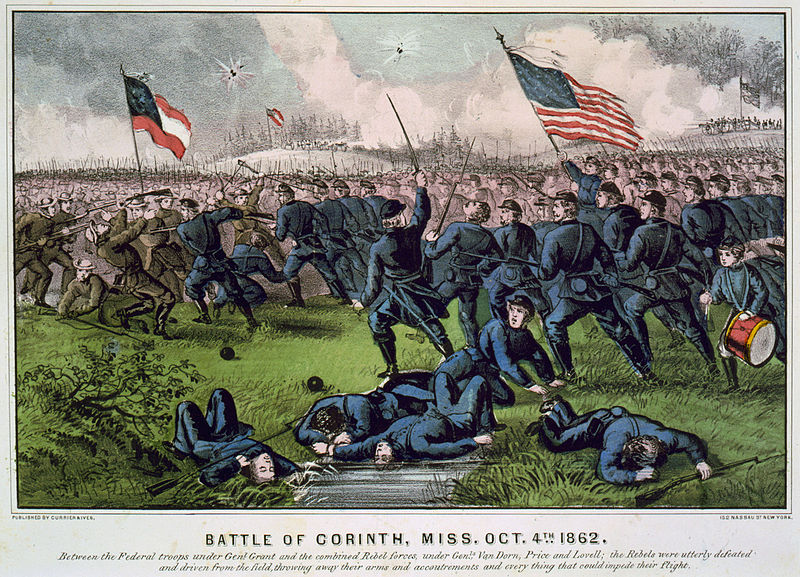
Rendition of the Second Battle of Corinth, Mississippi, second day (October 4, 1862). Hand-colored lithograph by Currier and Ives, 1862.
Photograph Courtesy of the Library of Congress, item 90709052.
Not to be confused with the earlier Siege of Corinth, though much of the action was on the same
ground, and sometimes known as the 2nd Battle of Corinth, the Battle of Corinth was fought
October 3–4, 1862, in Corinth, Mississippi. Union Maj. Gen. William Rosecrans defeated a
Confederate army under Maj. Gen. Earl Van Dorn.
A smaller part of the overall Confederate offensive of 1862 which included the Battle of
Perryville in Kentucky and the Battle of Antietam, or Sharpsburg, in Maryland, the Battle of
Corinth often gets lost in the larger history of the War. However, the fight in Corinth during the
unseasonably warm autumn days in 1862 in North Mississippi was a major battle and ranks in
the top 20 statistically in terms of troops engaged and casualties when compared with all other
Civil War battles. Despite early successes of the Confederate attack the battle would turn into a
clear Federal victory and also lead to fighting just across the Tennessee border the next day
October 5, 1862, at the Battle of Davis Bridge.
Mississippi Central Railroad Campaign
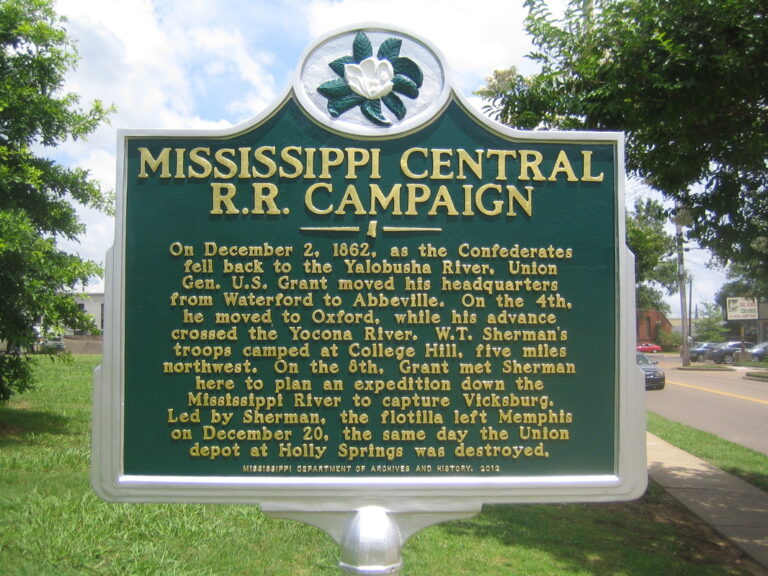
Image of a Mississippi Department of archives and history marker https://www.mississippimarkers.com/mississippi-central-rr-campaign.html
In November of 1862 Union General Ulysses S. Grant began his Mississippi Central Railroad
Campaign — the overland push into the heart of Mississippi with the goal of capturing
Vicksburg, a constant target for Union plans since May 1862. Slowly pushing down the railroad
and occupying North Mississippi towns such as Holly Springs and then Oxford Grant hoped to
chase and destroy the Confederate forces then led by General John Pemberton near Grenada,
Mississippi.
The Mississippi Central Railroad Campaign had early promise for Grant and the Federal forces,
but a series of December setbacks, disasters, and embarrassments would doom the campaign and
force Grant to reconsider a fully land based advance to the crucial river town of Vicksburg.
On December 5, 1862, at the Battle of Coffeeville, located between Oxford and Grenada,
Confederates successfully launched a large scale ambush on the vanguard elements of Grant’s
forces. Then later in the month Confederate General Earl Van Dorn would lead one of the most
daring cavalry operations of the entire War. The Raid on Holly Springs on December 20, 1862,
destroyed a large number of supplies intended to sustain the Federal forces on their way to
Vicksburg. Finally, in the days immediately following Christmas 1862 the Confederate Army
would decisively defeat the “water wing” of Grant’s offensive which had taken ships down the
Mississippi River in a rushed attempt to take Vicksburg by landing on the riverbanks just north
of the city. The result was the major Union defeat at Chickasaw Bayou. The Mississippi Central
Railroad Campaign was over, Grant would need to find another way to capture Vicksburg.
Battle of Okolona
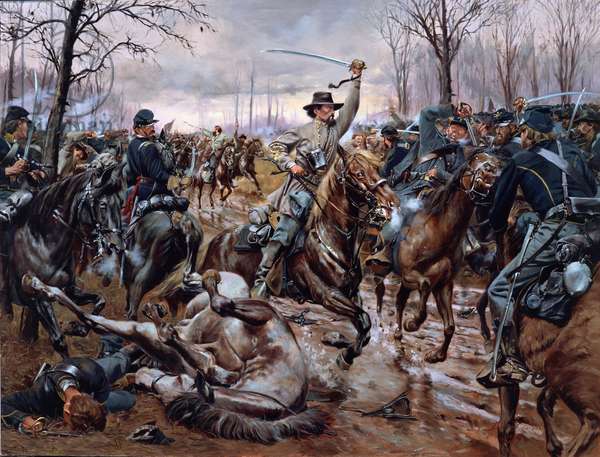
Southern Steel, Battle Of Okolona 1864, Oil Canvas by Don Troiani.
In February 1864 a sizable Union expedition left Memphis, Tennessee with the intent to join
forces with a large Union Army marching from Vicksburg towards Meridian, Mississippi. This
was the first of at least 6 sizable Union expeditions that left Memphis in 1864 to operate in North
Mississippi. The February 1864 expedition would not make it to Meridian, instead the “running”
Battle of Okolona took place on February 22, 1864, in Chickasaw County, Mississippi.
Confederate cavalry, numbering around 3,000 and commanded by General Nathan Bedford
Forrest, faced, and defeated, over 7,000 Federal troopers under the command of Union Brig.
Gen. William Sooy Smith.
Smith’s force had been ordered to set off from Memphis and rendezvous with the main Union
army of 20,000 that was marching on Meridian from Vicksburg and was under the command of
Maj. Gen. William Tecumseh Sherman. However, Smith did not fully understand or outright
disobeyed his orders and delayed the expeditions march south for ten days waiting for more
troops, horses, and supplies. When they eventually left Memphis the Union forces took part in
wide-spread destruction of the North Mississippi countryside. The Federal forces were later
harassed by Confederate cavalry and then on February 21 large numbers of Forrest’s men began
to engage the Federal forces directly. The main action of what would become known as the
Battle of Okolona was fought over an 11 mile stretch on February 22. Smith’s force was
thoroughly defeated and forced to flee back to Memphis.
Battle of Brice's Crossroads

‘Brice’s Crossroads” by Dan Nance
The Battle of Brice’s Crossroads, also known as the Battle of Tishomingo Creek or the Battle of
Guntown, was fought on June 10, 1864, near Baldwyn, Mississippi. A Federal expedition
numbering over 8,000 and under the command of Brigadier-General Samuel D. Sturgis, left
Memphis to get the attention of Confederate General Nathan B. Forrest and his Cavalry
Command that was operating in North Mississippi. The battle was a resounding victory for the
Confederates on the field, but it would delay, and ultimately prevent, Forrest from moving into
Tennessee to disrupt Union operations during the crucial Atlanta Campaign of 1864. Forrest
inflicted heavy casualties on the Federal force and captured more than 1,400 prisoners of war, 18
artillery pieces, and wagons loaded with supplies.
The battle would famously have an artillery charge successfully performed by the Confederates,
memorable brave service by the Union black troops of the USCT, and nearly a tactically perfect
battleplan by Forrest. One of the few Confederate victories of note in the Western Theater
Brice’s Crossroads has been studied by military tacticians and historians since the end of the
Civil War.
Battle of Tupelo/Harrisburg

Photo from The American Battlefield Trust https://www.battlefields.org/learn/maps/battle-tupelo-july-15-1864
Almost immediately after news of the Union defeat at Brice’s Crossroads reached Federal
authorities in Memphis another larger expedition was planned to keep the Confederates in North
Mississippi busy. Union forces led by General A.J. Smith launched yet another expedition out of
Memphis and by mid-July they had reached the area of Tupelo, Mississippi. Because of crafty
maneuvering Smith was able to keep the Confederates, led by Generals Stephen D. Lee and
Nathan B. Forrest, off balanced and guessing about Union intentions and objectives.
Sporadic fighting occurred on July 12 and 13 near Pontotoc and gunfights continued as the
Union Army moved toward the Harrisburg and Tupelo areas. On July 14 the Confederate
command attacked Union positions with no success and much bloodshed. The Union stand of
July 14 was followed up again on July 15 with a successful rearguard action against the
desperate Confederates at the Old Town Creek area of Tupelo. Though the Union expedition
would begin a return march to Memphis without launching an attack against the demoralized
Confederates the actions of July 12-15, collectively known as the Battle of Tupelo, or Harrisburg,
is seen as a clear Union victory by historians. Once again, as at the Battle of Brice’s Crossroads
the black troops of the USCT performed admirable during the Tupelo expedition.
Occupation and Destruction of Oxford
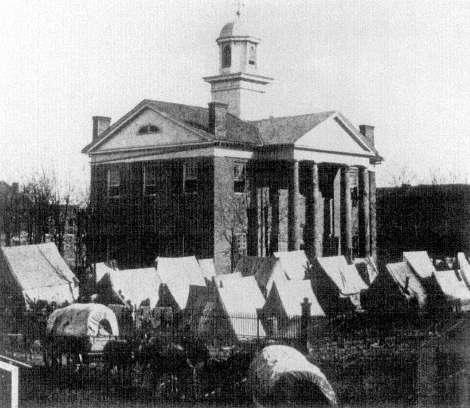
Original Courthouse during 1862 occupation.
Oxford had escaped total destruction when a major Union Army had occupied the town in 1862.
However, in August 1864 another Union expedition left Memphis to operate in North
Mississippi. With Federal General A.J. Smith in command the town would not be so lucky again.
After sporadic skirmishing with Confederate forces on the advance south, notably at Hurricane
Creek, Union forces would return to Memphis. But not before learning the Confederates had
made a totally unexpected slashing raid on the Tennessee town, and after the Union expedition
had burned the majority of Oxford.
Battle of Egypt Station
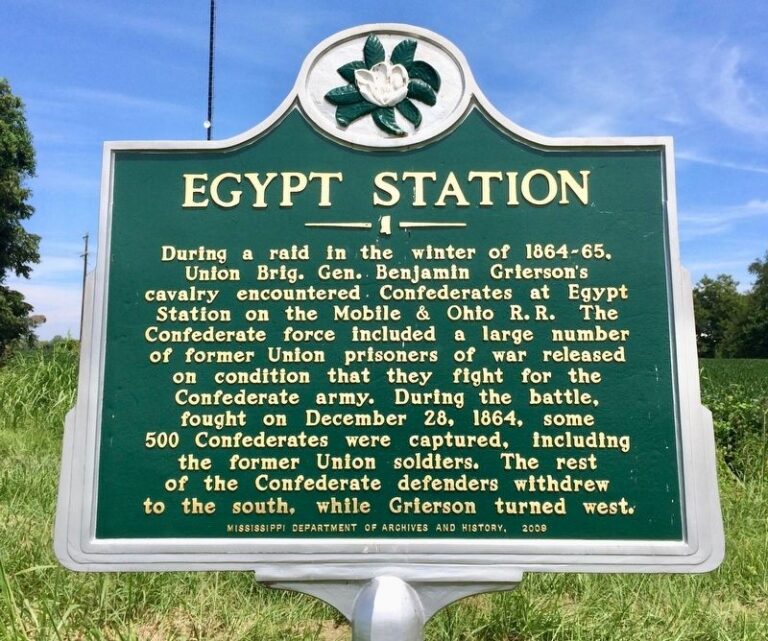
Image of a Mississippi Department of archives and history marker courtesy of https://www.hmdb.org/m.asp?m=107541
A small and little-known engagement took place near the end of 1864 in North Mississippi. The
Battle of Egypt Station was fought in the last days of December 1864 near the Mobile and Ohio
Railroad. Union forces led by General Benjamin Grierson would capture nearly 500
Confederates, some of whom had been former Federal Soldiers that were prisoners at the infamous Andersonville.
Offered freedom to “galvanize” and join the rebel ranks some of these Federal soldiers would do
just that and found themselves in combat against their former comrades.
Union forces would suffer nearly 150 casualties in the brief fight that was an overall Federal
success and closed nearly 3 years of battles, raids, expeditions, and skirmishes in North
Mississippi.